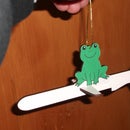Introduction: Wildlife-Friendly Rat Trap
My neighbours keep chickens in their garden.
Which means they also keep rats.
The chickens stay on their property.
The rats do not.
There are a few species of rat in New Zealand, all of them invasive and introduced by humans. They eat pretty much everything, and are very bad for the native bird species. Plus, they are rats, so I don't want them on my property.
The Department of Conservation publishes guidelines for trapping in urban areas which give specifications for the trap housing which minimise the chances of killing any native species, such as weta. To stay safe, you want the trap to be 500mm (18 inches) deep in a tunnel, have an access to the tunnel of 45mmx45mm (Inch and three-quarter square).
An additional requirement is to need tools to access the trap (which is mainly to stop any passing kids getting their fingers trapped).
Step 1: Acquire Timber (Lumber)
Hop into your compact car and find a nearby pallet.
This one was about four foot across, so cutting the boards just before the outer rails meant that I only needed to extract the nails from the centre of the boards. This is faster, and reduces the chance of splitting the wood.
Once the boards are off, pick four good ones and line them up on a workhorse to cut them all to the same length at once. I wasn't short of space to lay the trap, so I made the boards about 650mm (two feet) long.
Step 2: Build the U-Tunnel
To let air flow through the trap tunnel, carrying the delicious aroma of bait, there needs to be gaps at each end, but to make sure that the rat approaches from the trigger side of the trap, there must only be access from one end. The $2 shop kindly supplied some metal mesh sink drain filters which would allow air through, but prevent access and not be chewable
To allow access for resetting the trap, I used three boards to make a U-shaped tunnel base, and some offcuts from the boards to act as spacers at the top.
The boards were just screwed together. The boards were about 12mm thick (half an inch) so 25mm (one inch) screws were good enough.
Step 3: Fitting the Ends
I cut a piece from one of the board offcuts to make one end, then cut a 45mm (1 3/4") square from one corner of it. This trap tunnel is generally a bit of an emergency hack, but I did sand the edges of the entrance: there's no point in having splinters deter the rat from entering.
The other end of the tunnel had a smaller piece of wood fitted, with some metal mesh above it. The filter was just held in place with three screws, 12mm (half inch) since they were just going into a single layer of wood.
Step 4: Fitting the Tunnel Roof
The boards are not great timber, so since the roof will be subject to repeated removal of screws, i fitted some extra padding pieces of scrap to give a bit more strength.
The idea was to have the top fixed loosely at the entrance end, with the screw at the trap end being removed to allow the lid to swivel aside for access in clearing and resetting the trap.
Step 5: Wood Preservative
The finished project is going to be out in all weathers, so I gave it a coat of generic wood preservative. This is great stuff, but somewhat hideously toxic, so rather than use a good brush, I used a really cheap one and threw it away afterwards.
As a tip, leave this to dry outside: it really stinks your house out.
Step 6: And Now We Wait
Smooth peanut butter is supposed to be a great bait for traps, and certainly it has worked for me in the past.
Once everything is set and the lid is safely screwed in place, then you (and the trap) are all set.
Good hunting!











